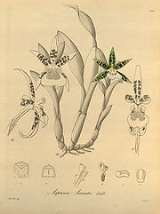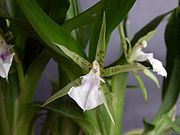
Aspasia lunata
Encyclopedia
Aspasia lunata is a species of orchid, native to tropical South America, in the Brazil
ian southeast and south and reaching Bolivia
and Paraguay
, from 200–750 m (656.2–2,460.6 ft) in elevation.

Aspasia lunata is primarily an epiphyte
on thick stems but often is found living over rock grooves covered by fallen leaves and humid forest
s where they never are exposed to direct-straight sunlight
.
Brazil
Brazil , officially the Federative Republic of Brazil , is the largest country in South America. It is the world's fifth largest country, both by geographical area and by population with over 192 million people...
ian southeast and south and reaching Bolivia
Bolivia
Bolivia officially known as Plurinational State of Bolivia , is a landlocked country in central South America. It is the poorest country in South America...
and Paraguay
Paraguay
Paraguay , officially the Republic of Paraguay , is a landlocked country in South America. It is bordered by Argentina to the south and southwest, Brazil to the east and northeast, and Bolivia to the northwest. Paraguay lies on both banks of the Paraguay River, which runs through the center of the...
, from 200–750 m (656.2–2,460.6 ft) in elevation.

Description
It forms large colonies, however, being not a particularly common species, it is just occasionally found, mostly on areas of transition between shady forest and open areas both in rain forests and cloud montane forests.Aspasia lunata is primarily an epiphyte
Epiphyte
An epiphyte is a plant that grows upon another plant non-parasitically or sometimes upon some other object , derives its moisture and nutrients from the air and rain and sometimes from debris accumulating around it, and is found in the temperate zone and in the...
on thick stems but often is found living over rock grooves covered by fallen leaves and humid forest
Forest
A forest, also referred to as a wood or the woods, is an area with a high density of trees. As with cities, depending where you are in the world, what is considered a forest may vary significantly in size and have various classification according to how and what of the forest is composed...
s where they never are exposed to direct-straight sunlight
Sunlight
Sunlight, in the broad sense, is the total frequency spectrum of electromagnetic radiation given off by the Sun. On Earth, sunlight is filtered through the Earth's atmosphere, and solar radiation is obvious as daylight when the Sun is above the horizon.When the direct solar radiation is not blocked...
.

